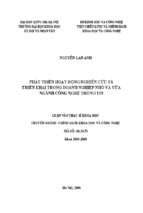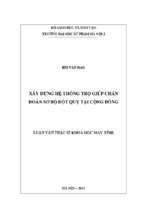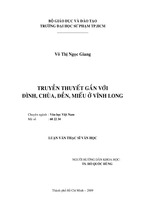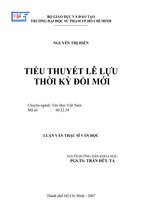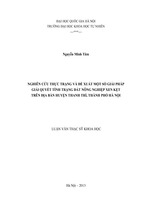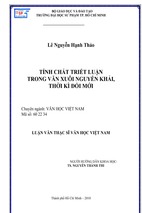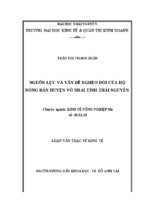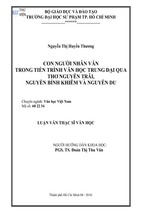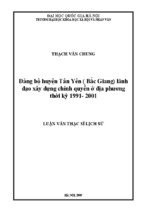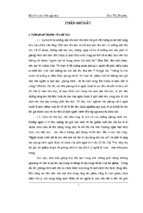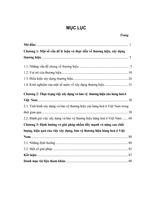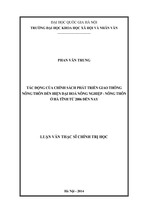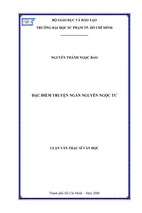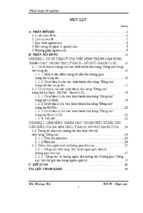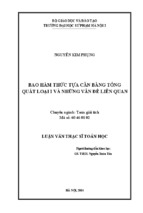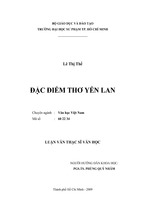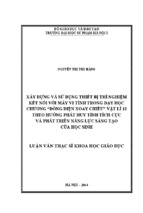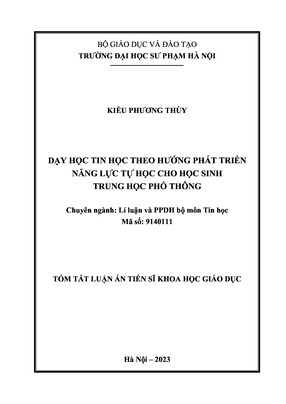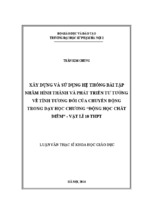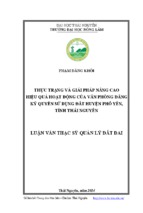BỘ GIÁO DỤC VÀ ĐÀO TẠO
TRƯỜNG ĐẠI HỌC CÔNG NGHỆ ĐỒNG NAI
BÁO CÁO TỔNG KẾT
ĐỀ TÀI NGHIÊN CỨU KHOA HỌC CẤP TRƯỜNG
A STUDY OF IMPACT OF PART-TIME JOBS ON
STUDENT'S PERFORMANCE
(NGHIÊN CỨU VỀ NHỮNG ẢNH HƯỞNG CỦA
CÔNG VIỆC BÁN THỜI GIAN ĐẾN QUÁ TRÌNH
HỌC TẬP CỦA SINH VIÊN)
Mã số: TR:2020-01/NN
Chủ nhiệm đề tài: ThS. Huỳnh Như Yến Nhi
Đồng Nai, Tháng 3, 2021
BỘ GIÁO DỤC VÀ ĐÀO TẠO
TRƯỜNG ĐẠI HỌC CÔNG NGHỆ ĐỒNG NAI
BÁO CÁO TỔNG KẾT
ĐỀ TÀI NGHIÊN CỨU KHOA HỌC CẤP TRƯỜNG
A STUDY OF IMPACT OF PART-TIME JOBS ON
STUDENT'S PERFORMANCE
(NGHIÊN CỨU VỀ NHỮNG ẢNH HƯỞNG CỦA
CÔNG VIỆC BÁN THỜI GIAN ĐẾN QUÁ TRÌNH
HỌC TẬP CỦA SINH VIÊN)
Mã số: TR:2020-01/NN
Chủ nhiệm đề tài
(ký, họ tên)
Đồng Nai, Tháng 3, 2021
DANH SÁCH THÀNH VIÊN THAM GIA NGHIÊN CỨU ĐỀ TÀI
STT
Họ tên
Vai trò
1
Huỳnh Như Yến Nhi
Chủ nhiệm đề tài
2
Nguyễn Ngọc Lynh Đan
Thành viên
3
Vũ Công Tài
Thành viên
4
Nguyễn Văn Tú
Thành viên
MỤC LỤC
THÔNG TIN KẾT QUẢ NGHIÊN CỨU ĐỀ TÀI NGHIÊN CỨU KHOA HỌC CẤP
TRƯỜNG ................................................................................................................................... 1
1. Thông tin chung: ..................................................................................................................... 1
2. Mục tiêu: ................................................................................................................................. 1
3. Nội dung chính: ...................................................................................................................... 1
4. Kết quả chính đạt được: .......................................................................................................... 2
CHAPTER 1: INTRODUCTION ............................................................................................... 3
1.1. Background of the study .................................................................................................. 3
1.2. Aim of the study .............................................................................................................. 4
1.3. Research questions .......................................................................................................... 5
CHAPTER 2: LITERATURE REVIEW .................................................................................... 6
2.1. Definitions of terms ......................................................................................................... 6
2.2. Review of related literature ............................................................................................. 6
2.3. Conceptual framework of the study ................................................................................ 8
CHAPTER 3: RESEARCH METHODOLOGY ...................................................................... 11
3.1. Context of the study....................................................................................................... 11
3.2. Research design ............................................................................................................. 11
3.3 Research tool .................................................................................................................. 12
3.4 Data collection procedure ............................................................................................... 12
CHAPTER 4: FINDINGS AND DISCUSSION ...................................................................... 13
CHAPTER 5: CONCLUSION ................................................................................................. 18
References ................................................................................................................................ 19
THÔNG TIN KẾT QUẢ NGHIÊN CỨU
ĐỀ TÀI NGHIÊN CỨU KHOA HỌC CẤP TRƯỜNG
1. Thông tin chung:
- Tên đề tài: A Study of Impact of Part-Time Jobs on Student's Performance
(Nghiên cứu về những ảnh hưởng của công việc bán thời gian đến quá trình học tập
của sinh viên)
- Mã số: TR:2020-01/NN
- Chủ nhiệm đề tài: Huỳnh Như Yến Nhi
Điện thoại: 0933055089
Email:
[email protected]
- Đơn vị quản lý về chuyên môn: Khoa Ngoại ngữ
- Thời gian thực hiện: Tháng 07/2020 đến tháng 03/2021
2. Mục tiêu:
Mục đích của đề tài này là tìm hiểu những ảnh hưởng tác động của việc sinh viên làm
công việc bán thời gian. Đối tượng nghiên cứu là sinh viên của trường Đại học Công
nghệ Đồng Nai. Từ các nghiên cứu trước đây, có thể thấy rằng việc làm bán thời gian
rất phổ biến ở nước ngoài, nhưng khi bắt đầu xu hướng này ở Việt nam, hầu hết sinh
viên làm thêm chiếm quá nhiều thời gian học tập và phần lớn sinh viên đều làm công
việc bán thời gian trái với ngành nghề được đào tạo ở trường đại học, điều này có thể
ảnh hưởng tiêu cực đến kết quả học tập của sinh viên. Chính vì vậy, đề tài NCKH của
nhóm tác giả mong muốn tìm hiểu và cung cấp cái nhìn sâu sắc về tác động của công
việc bán thời gian đối với kết quả học tập của sinh viên bằng cách tìm hiểu những lý
do vì sao nhiều sinh viên chọn đi làm thêm; Những tác động tích cực đến kết quả học
tập của sinh viên khi họ có một công việc làm thêm; và Những ảnh hưởng tiêu cực đến
kết quả học tập của sinh viên khi đi làm thêm.
3. Nội dung chính:
Đề tài đã sử dụng dữ liệu từ cả nguồn thứ cấp và sơ cấp. Dữ liệu thứ cấp đã được sử
dụng để chuẩn bị khung khái niệm của nghiên cứu. Để thu thập dữ liệu sơ cấp, một
cuộc khảo sát đã được thực hiện giữa các sinh viên trường Đại học Công nghệ Đồng
Nai (n = 50). Đề tài nghiên cứu đã đặt ra 20 câu hỏi cho những người được hỏi, bao
gồm thông tin cá nhân, chuyên ngành, hoạt động việc làm, kế hoạch nghề nghiệp
tương lai, v.v. Nhóm nghiên cứu chỉ khảo sát những sinh viên đã tham gia làm việc
bán thời gian trong thời gian khảo sát. Tổng số 50 bảng câu hỏi cuối cùng đã được
1
chấp nhận sử dụng. Chi tiết về các câu hỏi và câu trả lời đã được trình bày trong phần
kết quả. Đề tài nghiên cứu đã cố gắng tìm hiểu xem sinh viên có nhận thức được tác
động của việc làm thêm hay không. Khi làm như vậy, chúng tôi đã hỏi những người
được hỏi rằng công việc ảnh hưởng đến kết quả học tập của họ như thế nào. Chúng tôi
nhận thấy rằng hầu hết những người được hỏi đều biết rằng vì công việc họ sẽ không
có đủ thời gian để học. Dữ liệu khảo sát chỉ ra rằng sinh viên cảm thấy mệt mỏi và
không có đủ thời gian để học trong khi làm công việc bán thời gian. Tuy nhiên, nếu xét
về nghề nghiệp của họ sau khi tốt nghiệp, làm công việc bán thời gian trong quá trình
học tập dường như là cách duy nhất để có được kinh nghiệm làm việc và phát triển các
kỹ năng cho việc làm trong tương lai. Các khóa học đại học yêu cầu đủ thời gian để
lĩnh hội những kiến thức phức tạp để vượt qua các bài tập và kỳ thi. Vì vậy, việc quản
lý thời gian và cân bằng giữa công việc và học tập là rất cần thiết đối với sinh viên.
4. Kết quả chính đạt được:
Đề tài nghiên cứu này nhằm xem xét tác động của việc làm thêm trong quá trình học
đối với sinh viên trường Đại học Công nghệ Đồng Nai. Một cuộc khảo sát đã được
thực hiện để thu thập dữ liệu sơ cấp và nhóm nghiên cứu nhận thấy rằng sinh viên hầu
hết làm việc trong ngành dịch vụ với mức lương thấp hơn. Đa số sinh viên làm việc tại
các nhà hàng, trung tâm tiếng Anh hoặc các cửa hàng có mức thu nhập nhân viên cao
hơn. Hầu hết công việc không liên quan đến chuyên ngành đào tạo của họ. Nhiều sinh
viên làm việc nhiều giờ hơn thời khóa biểu chính khóa trên trường. Tình trạng này
không chỉ làm giảm thời gian học tập mà còn khiến các em cảm thấy quá mệt mỏi, khó
tập trung vào việc học. Sinh viên có kế hoạch học tập sẽ biết cách quản lý thời gian
như thời gian học, thời gian đi làm và sẽ giúp sinh viên có được những kỹ năng công
việc và kỹ năng giao tiếp xã hội cần thiết. Một số sinh viên phản ánh cảm thấy tự tin
hơn trong giao tiếp khi có các công việc làm thêm. Kế hoạch học tập có thể giúp sinh
viên quản lý tốt việc học và làm việc của mình. Các nhà quản trị giáo dục bậc đại học
có thể xem xét lồng ghép những khóa học về quản lý thời gian, thực hành kế hoạch
học tập để sinh viên ý thức hơn và thực hành cách cân bằng hiệu quả giữa công việc
làm bán thời gian và việc học của mình.
2
CHAPTER 1: INTRODUCTION
1.1. Background of the study
Part-time employment is becoming quite popular among young generations,
especially among college and university students of Viet Nam. Youth is the time of
working and youth represented by students. Part-time job works as a first step of
starting to work, dream and leads one towards a better life. Working alongside studies
is beneficial for students. In the article “Importance of Part-time employment” Paul
Hubert Casselman asserts that students are one of the major parts of part-time
employment and it also helps students to be experienced. Money is a major factor
working part-time but experiences which students gather through the job cannot be
ignored (Casselman, 2014). Part-time job means people do not need to occupy
themselves for the whole day but more or less they will enjoy the benefits of having a
job. In the broad sense, part-time employment includes all paid work performed in
addition to a full-time job or occupation; it generally excludes seasonal employment or
employment which recurs at certain times of the year, such as summer or Christmas
holiday work by students or teachers (Casselman, 2014). Basically, part-time job is
just the thing for students. It is very much popular among students. Generally, a person
started to learn after his birth, but lesson and experience of youth is the main pillar of
one’s career and life.
The trend of employment among university students has been increasing rapidly
in the last decade. Some suggest that economic reasons are mainly the factor for this
trend. With an increase in the number of students taking part-time job outside campus,
its effect on students’ academic performance of students has been questioned by many
researchers. Issues such as the number of hours worked, whether the student’s jobs
pertain to their majors, and student’s workloads have been discussed and scrutinized to
see the relation between taking part-time jobs and academic achievement (Watanabe,
2005).
Furr & Elling, (2000) suggest that there are many reasons why students take a
part time job. First, financial problems become mostly reasons for some of students
forced to take part time jobs. The average yearly costs of education and living continue
to increase in Vietnam. Secondly, students’ involvement in employment has positive
3
impact to develop career-related skills. It is hands-on experience that cannot be gained
in the classroom alone. Whatever the reasons the students have in taking part time job,
there is a popular belief that students with part-time job do not tend to have higher
academic achievement, because their focus time of study has been divided with their
working time. Better academic achievement only can be achieved by students who
spend more time on academic related activities outside of class; e.g., reading the text,
completing assignment, studying, and preparing reports.
The trend of part-time job is very common in abroad, especially in Vietnam.
There are two opinions regarding the impact of part-time work on students’ academic
performance. While one group of researchers claims that students gain work skills and
experience from job, other group believes that spending too much time on job distracts
students from study which contributes to poor academic performance in school. But
whether the impact of part-time work would be positive or negative on the students’
academic performance depends on the balance of time between work and study.
So far, researches on the involvement of students taking part-time jobs have
largely been conducted at universities in developed countries. Little, if any, has been
reported on this issue when it comes to university students in developing countries like
Vietnam. Therefore, the researcher sees the need to explore the issue of students’
involvement in part-time jobs at Dong Nai Technology University. It is located in the
Dong Nai province, one of Viet Nam’s main manufacturing centers.
1.2. Aim of the study
The aim of this study is to explore the consequence of students getting engaged
in part-time work alongside their studies. From previous studies, the researcher found
that part-time employment is very common in abroad, but at the very beginning of this
trend in our country most of the part-time employees were full-time graduates. The
survey and data shows at present maximum number of the students are fond of
spending longer time in their jobs rather than studying. Moreover, this paper will try to
give an idea about the outcome of combining studies and part-time job together.
4
1.3. Research questions
The study aims at providing insight to impact of part-time job on students’
academic performance by considering the following questions:
1. Why do many students choose to have a part-time job?
2. What are the positive effects on students’ academic performance when they
have a part-time job?
3. What are the negative effects on students’ academic performance when they
have a part-time job?
5
CHAPTER 2: LITERATURE REVIEW
2.1. Definitions of terms
According to International Labour Organization (2003) part-time job is a form of
employment that carries fewer hours per week than full-time job. Workers are
considered to be part-time if they commonly work fewer than 30 or 35 hours per week.
When it comes to the length of time spent in part time job, different countries
have different amount of working hours. In Australia, (2007) part-time employment is
employees that work fewer hours than the full time counterparts within a specific
industry, and mostly the time worked is less than 32 hours per weeks. In Canada
(2007), employee that is considered as part-time is the one who usually works fewer
than 30 hours per week at their main or only job. Almost the same, according to the
Statistic of Labor Bureau, working part time is defined as working between 1 and 34
hours per week. Unlike full-time employees, part time employees may not have the
entitlement given to those working full time. For example, in the United States (2009)
part time employees are not entitled to employee benefits, such as health insurance.
From the definitions mentioned earlier, it can be concluded that students with
part-time job can be defined as students working during semesters, with less than 20
working hours per week. Despite the variation of the amount of working hours, it is
common to see students work full time during semester break.
2.2.
Review of related literature
Many students have part-time jobs during their academic years. Both the positive
and negative impacts on students’ course performance from their term-time works
have presented by many researches.
Derous & Ryan, A.M, (2008) assert that part-time work also has advantages for
students’ academic outcomes and preparation for the future career when the job
relevant for students’ major and ran in a balanced way. Both students’ study attitudes
and performance benefited more when working hours was combined with high
autonomous motivation to perform the job, more specific, most positive effects would
from the combination of low working hours and high job demands. Their research
6
found plenty of information to illustrate the impact of employment and leisure
activities on students’ study attitude and well-being, while fewer significant effects on
the aspects of academic performance. Also, sample chosen there were psychology
students, mostly white and female, therefore limit the general covering for other group
of students.
On the contrary, part-time jobs can destroy one’s career and study. Some
environment of working places is not friendly for students. Job in bar, pub or places
like these are harmful for students. Sometimes they got bad company here and rather
than investing their time in productive work, they kill their time and also get involved
in illegal works. In addition, money is the major factor in par-time job; this is why
some students tend to think if they can make money without having any degree then
what is the point of working hard for study? Ultimately, after getting a degree people
start working for money, which anyone can do without a degree. That is why gradually
they lose the desire of studying. Researchers Herbert Marsh and Sabina found that
working part-time declines students’ grades, their academic and career goals get lower
and most importantly they likely to miss the classes (Anderson & Demand, 2014).
Furthermore, high school students who work part-time became unsocial and
sometimes they felt left out and isolated from friends; found in another study
(Anderson & Demand, 2014). As has been stated earlier that it depends on the person
how one balanced both study and job together. Mccoy & et al. (2009) also agreed to
this that if one wants to do job then that person will definitely manage time job without
hampering study.
Concerns on the effect of part-time jobs towards students’ academic performance
do not come out of thin air. Most researches indicate that there is a detrimental effect
on academic achievement if secondary students work for over 15 hours a week (Stern,
1997). Such students have lower grades, do less homework, are more likely to drop
out, and are less likely to enter post-secondary education. Those students who work
fewer hours suffer several negative consequences.
These finding are supported by a Toronto study showing that students working
more than 20 hours had a 16% dropout rate, and those who worked longer than 20
hours has even bigger drop-out rate of 33% (Cheng, 1995).
7
Sighn, (1998) in his study which factored in socio-economic status and previous
achievement states that the more hours worked the greater negative effects on student
achievement. The consequences for young students working longer hours could be
more severe than for older students (Barone, 1993). Many students who work find
some problems balancing school and work demands (Worley, 1995). Many who work
part-time have limited participation in extra-curricular activities (Hope, 1990). Many
researches indicating that employment have negatively affected students’ academic
achievement stated that an increase in the amount of hours worked of the most
influence factors (Watanabe, 2005).
Intriguing findings have been put forward by The National Center for Education
Statistics (NCES, 1994), which is run by the U.S. Department of Education and Marx
and Dundes (2006). NCES found that students working 1-15 hours weekly have a
significantly higher GPA than both students working 16 or more hours and students
who do not work at all. The NCES is the primary federal entity for collecting and
analyzing data related to education.
Many sources concluded that working less than 15 hours per week had little or no
effect on students’ academic achievement. Following an in-depth study of the topic,
included in the journal of human resources, (Ehrenberg & Sherman, 1987) stated, “We
do not find any strong evidence… that hours of work during the academic year in the
range that student worked significantly reduced grade point averages.”
Dundes & Marx (2006) reported that 74% of student-workers believed that
employment forced them to become more efficient. Despite this fact, it is also reported
that 64% of students working part-time also have a higher of stress level.
The positive effects of on-campus employment are due to enhanced integration
with the institution, including involvement with other students and with faculty (Furr
& Elling, 2000). In addition, on campus jobs often include responsibilities with
academic components.
2.3.
Conceptual framework of the study
According to above mentioned studies, there are several reasons which drive
students to have part time employment. Most of the students think that their study
costs are higher than that they expected. Parents feel stressful to pay the expensive
8
tuition fees and other living costs. Thus, they try to find ways to finance their own
studies and to save money. They are mainly employed in the hospitality or retail
industries which have high staff turnover. Part time work for students has advantages
as well as disadvantages. Understanding the positive and negative consequences of
taking a part time job is important for students. Studies show that students who have
study time employment do better in study and score better academic results than other
students who do not work. Part time job could bring extra income and help university
students to gain working experience. The most important part is skillset, such as
working in an industry is a good way to improve communication skills, teamwork
skills and learn about time management. Students also have chance to meet new
friends. But students may feel sleepy and reduce time from study, thus it is a real
challenge to balance between part time job and study. Some students may feel hard to
complete assessment and be absent from class. It is essential that students should have
a reasonable number of working hours and try their best to balance between work and
study related responsibilities. The above studies further reveal that students from
different backgrounds have different perspective and attitudes towards part time
employment. There is an opinion that there are several reasons drive students to do
part time work and it does affect academic performance to some extent. First,
expensive university tuition fee becomes an economic burden to many families,
especially more expensive for international students. Students earn money through
hard work from part time job to reduce financial pressure of their family. And second,
it is a fact that the university is a bridge links to future of a professional career but the
reality of employment is that job seekers receive preference with past working
experience. It is even harder to find jobs for international students whose mother
tongue is not English. To consider about the career after graduation, doing part time
job after school seems the only way to obtain work experience and to develop job
skills. University courses require enough time to comprehend complex knowledge to
pass assignments and examinations. Thus, it is a severe test for students to manage
time and balance between work and study. Students who do part time job generally
have the following arguments in favor of their benefits. First, to achieve self-worth. In
school, not every college student is brilliant, sometimes face the loss of self-worth and
mental anguish. For this reason, some college students find another way to select the
9
right road to rediscover the share of feeling in this area. Second, earning money.
Money is not everything but no money not acceptable in life. This concept is
applicable to college students to pursue practical psychology and emphasizing selfreliance. Especially students from poor families do not want to meet tuition fee and
living cost from their parents. Therefore, choose to become a part-time tertiary student
which is an important way to solve the huge expenditure. Third, exercise self.
Currently, a prominent issue is the employment of college students’ face. This is an
unavoidable choice. For this reason, college students will exercise their space is not
limited to the campus and increasingly plunge into the colorful social life. Part-time
college students in order to exercise the ability to obtain social experience for future
job increase eligibility. Experience is the second qualification in the market and as the
market matures and business managers are increasingly employing the concept of
rational, this education of gold be gradually increased. Part-time work has some more
advantages for students such as it helps to solve the economic difficulties of many
tertiary international students, to improve the viability of the self; but at the same time,
the downside is very obvious, such as the employer's too harsh, so that students and
career and income is not hard to pay proportional, and some even cheap labor. And
part of normal academic impact on students’ performance cannot be ignored. Then the
simple question is why are so many students choose to work part time?
Existing literature further suggest that while some people claim that students gain
work skills and experience from job, others believe that spend too much time on part time job
distracts them from study and results in poor school performance. Whether students could
balance between work and study, will impact on their academic performance. There is a
difference on the results between domestic students and International students. The
Vietnamese government allows an international student to work maximum 20 hours per week.
This situation demands to examine the benefits and costs of part time work, and how the
students balance the time between work and study. This study aims to answer this question.
10
CHAPTER 3: RESEARCH METHODOLOGY
3.1. Context of the study
Dong Nai Technology University (DNTU) is the research context for this study.
Dong Nai Technology University was founded on June 16, 2011 as a result of the
upgrading of Dong Nai Technology College in Bien Hoa City, Dong Nai Province,
Vietnam.
Overcoming the difficulties and problems of its early years, Dong Nai University
of Technology continues to develop new facilities and equipment, as well as adequate
training programs and is frequently upgraded, with highly trained management and
technical personnel serving the transformation and industrialization of Dong Nai
province and its environs. Dong Nai Technology University has enrolled 17 majors for
Bachelor’s Degree and 2 majors for Master’s Degree. Per year, the number of students
grows in both quantity and consistency. Those numbers accurately represent the
DNTU's efficacy and potential for preparation.
Since Vietnam is now in the process of merging with its neighbors and other
countries around the world, the English language has become increasingly important in
a world where cultures and languages are diverse. As a result, the Faculty of Foreign
Languages (FFL) in DNTU is considered as one of the top destinations because it
offers students good training programs and great learning opportunities for English
majors. FFL has currently about 800 students from year 1 to year 4. The students come
from many regions in Vietnam and choose English language as their major.
3.2. Research design
The study has used data from both secondary and primary sources. Secondary data
have been used to prepare the conceptual framework of the study. To collect primary
data, a survey was conducted among the students at Dong Nai Technology University
(n = 50). The study has asked 20 questions to respondents which included their
personal profile, study area, employment activities, future career plan, etc. The
researchers have interviewed only who were involved in part time work during survey
time. Total 50 questionnaires were finally accepted to use. Details of questions and
responses have been presented in findings section.
11
3.3 Research tool
To answer research questions, the researchers used survey questionnaire. The
main purpose of the questionnaire is to extract data from the respondents. It's a
relatively inexpensive, quick, and efficient way of collecting large amounts of data
even when the researcher is not present to collect those responses first hand. In this
research, the author intended to use the questionnaire for collecting quantitative data.
The structure of the questionnaire is as follows:
Part one: Personal information of the respondents
This questionnaire covered the background to the respondents ' personal
information. Demographic details include male, female, gender, age, grade.
Part two: Questions for survey
The aim of this section is, in particular, to answer the research questions of this
research, by using 10 questions on the problems of English communication skills,
using the Five-Point Likert Scale to measure 100 participants’ replies, consisting of
five choices: strongly agree, agree, neutral, disagree, and strongly disagree.
3.4 Data collection procedure
The researchers posted the questionnaire onto Google docs, and sent it to
students to get the answers from them, and the time to complete the questionnaire is in
3 weeks (30/1/2021 to 20/2/2021).
After 3 weeks to complete the survey, the
researchers transcribed all the results of each participant. Excel was used to help the
author analyze the research data in this study.
12
CHAPTER 4: FINDINGS AND DISCUSSION
This chapter presents findings of the study. About 60% of respondents was male
and 40% was female. This ratio is consistent with the real picture of Dong Nai
Technology University.
The study found that the most common job that available for students to do as
part time are sales, waiter/ waitress, tutor, cashier, teacher and assistant. Many of
them work in restaurants, takeaway outlets, English center and shops. The turnover
of those kind of jobs are quite high. Many companies would like to hire the students
as a part time worker due to the low wage payment.
As the purpose of the study is to examine the impact of part time work on the
students’ academic performance and, generally they work in industries such as
hospitality and tourism, the study intended to know whether the work was related to
students’ career interest. Only 24% of the respondents said that the work was related
to their study discipline. The rest 76% respondents informed that the work was
either partly related to the study discipline or not at all related to it. This scenario
tells us that income is the priority for most of the international students while they
study to meet their study related costs.
The researcher tried to understand the students’ level of satisfaction they get
from their work. Figure 1 presents the degree of satisfaction level. It shows that
most of the students are satisfied with their work irrespective of whether the work
relates to their career path or not. The reason may be that the students work mostly
in restaurants or shops that have high employee turnover. Managers may not pay
much attention at management level of part time employees’ intentions to work.
Only 4% of the respondents indicated that they were not happy with their work.
13
Figure 1: How do students evaluate their part time job?
Source: Survey data
Whether part time work affects students’ academic performance or not is presented in
Figure 2
Figure 2: Does the part time job affect the study hours?
Source: Survey data
14
Figure 2 shows that only 10 per cent of the students think that part time jobs
reduce their study time. Whereas a majority, ninety per cent of the students think
that part time jobs do not affect their study time. Experience says that if students
could balance the study time and part time work, it would not affect the study
seriously. Another reason might be that some students work over the allocated or
planned time. That additional work load does not only reduce the study time but
also makes them feel too tired to concentrate on studies.
Studies found that 40% of the respondents are paid wages lower than the
minimum wage. Forty-two per cent are paid wages equal to the minimum wage.
Only 18% of the students get paid wages higher than the minimum wage.
Ironically, many students do hard work but get the minimum or lower than
minimum wage. Their income and work load is not balanced.
One of the survey questions was whether the students had any study plan while
they worked. We found that there were 21 (42%) students out of 50 who had a study
plan while 29 (58%) students did not have any study plan. If students have study
plan, they know clearly what time to study and what time to work. The study plan
can help them manage their study and work well. Educational institutions can play a
vital role teaching learners about time management by practicing work plan. Figure
3 presents how many hours students work per week.
Figure 3: The work hours during the week
Source: Survey data
15
Figure 3 shows that 20% of the students work five to ten hours per week. 60%
students work ten to fifteen hours per week. 10% students work over twenty hours
per week. According to Vietnamese law, a student can work maximum 20 hours per
week during study time. If students work more than 20 hours per week it reduces
the study time which may have negative influence on their academic performance.
The study also found that there are several reasons that drive students to do part
time work and it does affect academic performance to some extent. Firstly,
expensive university tuition fee becomes an economic burden to many families,
particularly for international students. Students acquire money through hard work
from part time job to reduce financial pressure of their parents. Second, university is
a bridge that links to future career. The reality of employment is that applicants
receive preference with past working experience. It is even harder to find jobs for
international students whose English is a second language. It indicates that findings
of this study is consistent with the existing literature of this field.
The study further wanted to know the main purpose of students’ involvement in
part time work during their study time. Respondents’ purpose of work is presented
in Table 1.
Table1: The purpose of working
The purpose of working
Numbers
Money
32 (64%)
Gain working experience
33 (66%)
Make new friends
16 (32%)
Make use of leisure time
26 (52%)
Get to know society and practice yourself
24 (48%)
Source: Survey data. Note: Respondents’ responses reflect frequency only, not
necessarily be equal to 100%.
Table 1 shows that most students work to gain experience (66%) followed by
64% for raising disposable income. Combining these two categories, it appears that
about two third of students work part time during their study time for reducing the
burden of cost of education on parents and also to be familiar with new work
16


